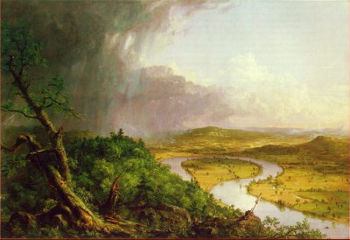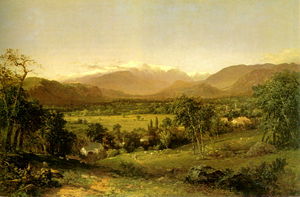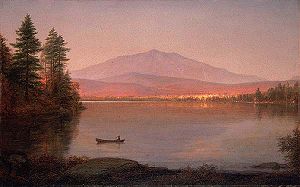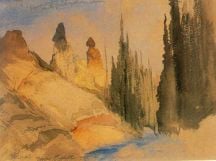Difference between revisions of "Hudson River School" - New World Encyclopedia
(images ok) |
|||
| Line 1: | Line 1: | ||
| − | {{Ready}}{{Contracted}}{{Started}}{{Submitted}} | + | {{images OK}}{{Ready}}{{Contracted}}{{Started}}{{Submitted}} |
[[image:ThomasCole-TheOxbow.jpg|thumb|350px|[[Thomas Cole]]'s ''View from Mount Holyoke, Northampton, Massachusetts, after a Thunderstorm'', or ''The Oxbow'', 1836]] | [[image:ThomasCole-TheOxbow.jpg|thumb|350px|[[Thomas Cole]]'s ''View from Mount Holyoke, Northampton, Massachusetts, after a Thunderstorm'', or ''The Oxbow'', 1836]] | ||
The '''Hudson River School''' was a mid-[[19th century]] [[United States|American]] art movement formed by a group of [[landscape art|landscape]] [[painter]]s, whose aesthetic vision was influenced by [[romanticism]]. Their paintings depict the [[Hudson Valley|Hudson River Valley]] and the surrounding area, as well as the [[Catskill Mountains]], [[Adirondack Mountains]], and [[White Mountains (New Hampshire)|White Mountains of New Hampshire]]. Their artistic philosophy has been described as "being rooted in religious [[environmentalism]]," although the members of the group varied in their religious convictions.<ref>[http://home.att.net/~hudsonriverschool/home.htm]</ref> | The '''Hudson River School''' was a mid-[[19th century]] [[United States|American]] art movement formed by a group of [[landscape art|landscape]] [[painter]]s, whose aesthetic vision was influenced by [[romanticism]]. Their paintings depict the [[Hudson Valley|Hudson River Valley]] and the surrounding area, as well as the [[Catskill Mountains]], [[Adirondack Mountains]], and [[White Mountains (New Hampshire)|White Mountains of New Hampshire]]. Their artistic philosophy has been described as "being rooted in religious [[environmentalism]]," although the members of the group varied in their religious convictions.<ref>[http://home.att.net/~hudsonriverschool/home.htm]</ref> | ||
| − | Hudson River School artists believed that [[nature]] in the form of the American landscape was an "ineffable manifestation of [[God]]"<ref>[http://home.att.net/~hudsonriverschool/history_essay4.htm.] </ref>In his ''Essay on American Scenery'' for the ''American Monthly Magazine'' Thomas Cole wrote | + | Hudson River School artists believed that [[nature]] in the form of the American landscape was an "ineffable manifestation of [[God]]"<ref>[http://home.att.net/~hudsonriverschool/history_essay4.htm.] </ref> In his ''Essay on American Scenery'' for the ''American Monthly Magazine'' Thomas Cole wrote, "American Scenery is a subject that to every American ought to be of surpassing interest; for, whether he beholds the Hudson mingling waters with the Atlantic, explores the central wilds of this vast continent, or stands on the margin of the distant Oregon, he is still in the midst of American scenery—it is his own land; its beauty, its magnificence, its sublimity—all are his; and how undeserving of such a birthright, if he can turn towards it an unobserving eye, an unaffected heart!" |
| − | |||
Revision as of 16:08, 26 December 2007

The Hudson River School was a mid-19th century American art movement formed by a group of landscape painters, whose aesthetic vision was influenced by romanticism. Their paintings depict the Hudson River Valley and the surrounding area, as well as the Catskill Mountains, Adirondack Mountains, and White Mountains of New Hampshire. Their artistic philosophy has been described as "being rooted in religious environmentalism," although the members of the group varied in their religious convictions.[1]
Hudson River School artists believed that nature in the form of the American landscape was an "ineffable manifestation of God"[2] In his Essay on American Scenery for the American Monthly Magazine Thomas Cole wrote, "American Scenery is a subject that to every American ought to be of surpassing interest; for, whether he beholds the Hudson mingling waters with the Atlantic, explores the central wilds of this vast continent, or stands on the margin of the distant Oregon, he is still in the midst of American scenery—it is his own land; its beauty, its magnificence, its sublimity—all are his; and how undeserving of such a birthright, if he can turn towards it an unobserving eye, an unaffected heart!"
Background
The Hudson River School, like other groups such as the "The Ashcan School", or the "Brandywine School" refers not to a particular learning insitution but to a movement of artists whose outlook, inspiration, output, and style demonstrates a common theme. Well known artists of the group include Asher B. Durand, J. F. Kensett, S. F. B. Morse, Henry Inman, Jasper Cropsey, Frederick E. Church, and George Inness.[3]
The originator of the term Hudson River School is not entirely certain. It is thought to have originated either with the New York Tribune art critic Clarence Cook or the landscape painter Homer D. Martin (Howat, pages 3-4).
Hudson River School paintings reflect three themes of America in the 19th century: discovery, exploration, and settlement. The paintings also depict the American landscape as a pastoral setting, where human beings and nature coexist peacefully. Hudson River School landscapes are characterized by their realistic, detailed, and sometimes idealized portrayal of nature. In general, they took as their inspiration such European masters as Claude Lorrain, John Constable and J.M.W. Turner, and shared a reverence for America's natural beauty with contemporary American writers such as Henry David Thoreau, William Cullen Bryant and Ralph Waldo Emerson. Philosophy that shaped their art is expressed by the following sentiments:
- Nature is full of genius, full of the divinity; so that not a snowflake escapes its fashioning hand.[4]
-Henry David Thoreau
- Every natural fact is a symbol of some spiritual fact. Every appearance in nature corresponds to some state of the mind, and that state of the mind can only be described by presenting that natural appearance as its picture.[5]
-Ralph Waldo Emerson
While the elements of the paintings are rendered very realistically, many of the actual scenes are the synthesized compositions of multiple scenes or natural images observed by the artists. In gathering the visual data for their paintings, the artists would travel to extreme environments or locales, presenting the artists with unique challenges. During these expeditions, sketches and memories would be recorded and the paintings would be rendered later, upon the artists' safe return home.
Thomas Cole
The artist Thomas Cole is generally acknowledged as the founder of the Hudson River School. Cole took a steamship up the Hudson in the autumn of 1825, the same year the Erie Canal opened, stopping first at West Point, then at Catskill landing where he ventured west high up into the eastern Catskill Mountains of New York State to paint the first landscapes of the area. The first review of his work appeared in the New York Evening Post on Nov. 22, 1825[3]. Cole initiated a unique perspective of the area displayed in his renditions of monochromatic green landscapes, and the uniquely brilliant autumn hues of the area. Only twenty one years earlier, John Vanderlyn painted The Murder of Jane McCrea, symbolizing how dangerous rural areas of New York State could be, but now a new more idealized and peaceful view of the area was emerging through the work of Hudsron River School artists.[4]. Cole's close friend, Asher Durand, became a prominent figure in the school as well, particularly when the banknote-engraving business evaporated in the Panic of 1837.
Second generation
The second generation of Hudson River school artists emerged to prominence after Cole's premature death in 1848, including Cole's prize pupil Frederic Edwin Church, John Frederick Kensett, and Sanford Robinson Gifford. Works by artists of this second generation are often described as examples of Luminism, or the Luminist movement in American art. In addition to pursuing their art, many of the artists, including Kensett. Gifford and Church[6], were founders of the Metropolitan Museum of Art in New York City.
Most of the finest works of the Hudson River school were painted between 1855 and 1875. During that time, artists like Frederic Edwin Church and Albert Bierstadt were treated like major celebrities. When Church exhibited paintings like Niagara[5] or Icebergs of the North, [6] thousands of people would line up and pay fifty cents to view his work. The epic size of the landscapes in these paintings reminded Americans of the vast, untamed, but magnificent wilderness areas in their own locales, and their works helped inspire movements to settle the American West, preserve national parks, and create city parks.
Public collections
One of the largest collections of paintings by artists of the Hudson River School is at the Wadsworth Atheneum in Hartford, Connecticut. Some of the most notable works in the Atheneum's collection are thirteen landscapes done by Thomas Cole, and eleven by Hartford native Frederic Edwin Church, both of whom were personal friends of the museum's founder, Daniel Wadsworth. Other important collections of Hudson River School art can be seen at the Metropolitan Museum of Art and the New-York Historical Society, both in Manhattan, NY; the Brooklyn Museum in Brooklyn, NY; the National Gallery of Art in Washington, DC; the Gilcrease Museum in Tulsa, Oklahoma; the Newark Museum in Newark, NJ; and the Westervelt Warner Museum of American Art in Tuscaloosa, Alabama.
Selected artists working in the Hudson River School style
Notes
ReferencesISBN links support NWE through referral fees
- Howat, John K. American Paradise, The World of the Hudson River School. The Metropolitan Museum of Art, Harry N. Abrams, Inc., New York, 1987.
- [7] Hudson River School, Retrieved Dec. 18, 2007.
- [8] "Excerpts from Essay on American Scenery" by Thomas Cole Retrieved Dec. 19, 2007.
External links
- Overview of the Hudson River School. Retrieved December 14, 2007.
- White Mountain Art & Artists. Retrieved December 14, 2007.
- Albany Institute of History and Art. Retrieved December 14, 2007.
- Barrow, Jr. Mark. 2004. The Hudson River School History.vt.edu. Retrieved December 22, 2007.
- The Voyage of the Icebergs: Frederic Edwin Church's Arctic Masterpiece Retrieved December 14, 2007.
| ||||||||||||||
| Romanticism | |
|---|---|
| Eighteenth century - Nineteenth century | |
| Romantic music: Beethoven - Berlioz - Brahms - Chopin - Grieg - Liszt - Puccini - Schumann - Tchaikovsky - The Five - Verdi - Wagner | |
| Romantic poetry: Blake - Burns - Byron - Coleridge - Goethe - Hölderlin - Hugo - Keats - Lamartine - Leopardi - Lermontov - Mickiewicz - Nerval - Novalis - Pushkin - Shelley - Słowacki - Wordsworth | |
| Visual art and architecture: Brullov - Constable - Corot - Delacroix - Friedrich - Géricault - Gothic Revival architecture - Goya - Hudson River school - Leutze - Nazarene movement - Palmer - Turner | |
| Romantic culture: Bohemianism - Romantic nationalism | |
| << Age of Enlightenment | Victorianism >> Realism >> |
Credits
New World Encyclopedia writers and editors rewrote and completed the Wikipedia article in accordance with New World Encyclopedia standards. This article abides by terms of the Creative Commons CC-by-sa 3.0 License (CC-by-sa), which may be used and disseminated with proper attribution. Credit is due under the terms of this license that can reference both the New World Encyclopedia contributors and the selfless volunteer contributors of the Wikimedia Foundation. To cite this article click here for a list of acceptable citing formats.The history of earlier contributions by wikipedians is accessible to researchers here:
The history of this article since it was imported to New World Encyclopedia:
Note: Some restrictions may apply to use of individual images which are separately licensed.









